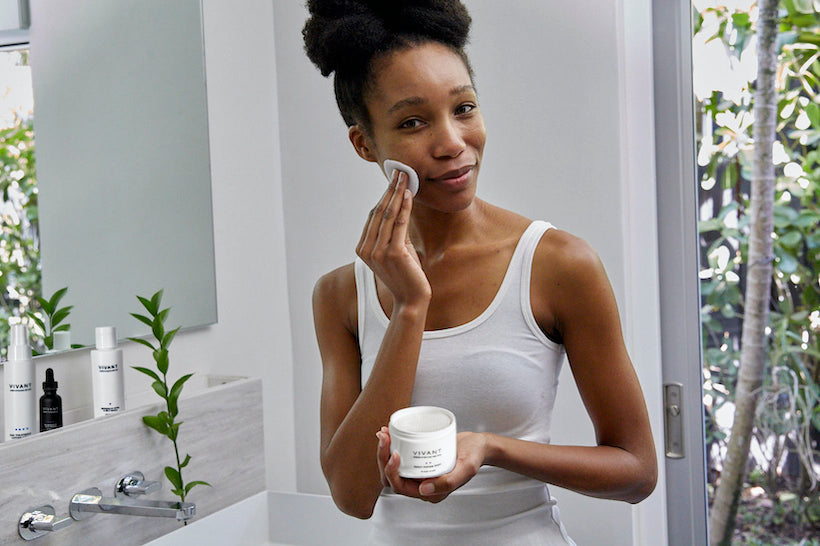5 Questions About Mandelic Acid Answered

Mandelic acid is one of our favorite ingredients and one of the pillars of the Vivant line. We love it because it takes on the trifecta of skin care’s biggest issues: acne, photo-aging, and hyperpigmentation. Mandelic acid’s larger molecular structure means its absorbed more slowly into the skin than other alpha-hydroxy acids, so it’s non-irritating. But despite all of its amazing benefits, mandelic acid is not as well-known as some of the other AHAs, and we get a lot of questions about it. So here are the answers to the five most asked questions about the gentle giant of AHAs, mandelic acid.
What is Mandelic Acid?
Mandelic Acid is an alpha hydroxy acid that’s derived from bitter almonds. It has a larger molecular structure than other AHAs so absorbs into the skin more slowly and doesn’t cause irritation that can trigger hyperpigmentation. It also has antibacterial, antifungal, and anti-inflammatory, and micro-exfoliating properties. And because it acts to inhibit tyrosinase, the enzyme that stimulates melanin production, it’s also a natural brightener.
What’s the difference between using Mandelic Acid vs. Vitamin A? Should I use both?
Both are exfoliating agents used to treat acne, hyperpigmentation, and photo-aging.
Vitamin A works best when combined with an antibacterial for acne and a lightening agent for hyperpigmentation. Mandelic Acid is a much gentler exfoliating agent than Vitamin A and can be used alone to treat acne, hyperpigmentation, and photo-aging at a slower rate, which does not cause reactive hyperpigmentation.
If your concern is acne, use Mandelic Acid 3-In-1 Wash or Mandelic Acid 3-In-1 Exfoliating Cleanser and one of our mandelic acid toners for the antibacterial properties, along with a vitamin A serum to peel out the deeper impactions.
Melanin suppressing properties make mandelic acid a top choice for targeting hyperpigmentation. Vitamin A accelerates cell turnover to aid in lifting pigment, but it does not suppress melanin production. The two can be used together to speed results.
For fine lines, you can use mandelic acid formulations, as well. But to treat more advanced photo-aging, vitamin A is still the king.
Who is mandelic acid for?
Mandelic acid is safe for all skin tones. It is a particularly good choice for skin of color because of its more gentle action. It won’t cause irritation that can trigger hyperpigmentation. Mandelic acid is safe for use during pregnancy to treat melasma, acne, and photo-aging. And it’s a favorite among men because it won’t sting when used after shaving and helps eliminate razor bumps and prevent ingrown hairs.
Which percentage should I choose?
For mild issues, or when you are using mandelic acid for the first time, go with the lower percentage. This allows your skin to acclimate. When you feel your skin has reached a maintenance plateau and you’d like to push your results farther, move up to the next percentage.
Can the 8% or 15% Mandelic Acid 3-In-1 Serum be used twice a day?
Absolutely. In fact, we recommend it. Though when you first begin using either one, you should start with once a day to allow your skin to acclimate, and work your way up to twice daily.


Comments
Thank you for your excellent wealth of information!!! Not only is your information on your products extremely educational, I greatly appreciate how you make it easy to understand what products are best for your skin and how to apply them!
Re Shay:
It might. The BP and Mandelic Acid Exfoliating Cleanser may make you peel a little because they exfoliate the skin.
I just have a question does the wash make you peel?
I have always enjoyed your comments, but today I found myself taking notes on what I call now my “Vivant knowledge notebook” . I honestly learn more reading your comments than in the esthetics book that I studied while becoming an aesthetician. I love the content you share and I can honestly say that now reading your posts and learning from them has become one of my daily routines.
Thank you for your generosity!